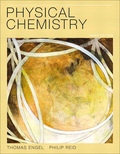
EBK PHYSICAL CHEMISTRY
3rd Edition
ISBN: 9780133556094
Author: Reid
Publisher: YUZU
expand_more
expand_more
format_list_bulleted
Question
Chapter 2, Problem 2.21NP
Interpretation Introduction
Interpretation: The change in enthalpy of 1.75 mol of
Concept Introduction: The change in enthalpy can be calculated as follows:
Here, n is number of moles,
Expert Solution & Answer
Want to see the full answer?
Check out a sample textbook solution
Students have asked these similar questions
What is the reactant that makes the following product of the reaction? Please provide a detailed explanation and a drawing to show how the reaction proceeds.
Draw the products formed when each ester is hydrolyzed with water and sulfuric acid.
Draw the complete structural formula from each condensed structure. include all hydrogen atoms.
Chapter 2 Solutions
EBK PHYSICAL CHEMISTRY
Ch. 2 - Prob. 2.1CPCh. 2 - Prob. 2.2CPCh. 2 - Prob. 2.3CPCh. 2 - Prob. 2.4CPCh. 2 - Prob. 2.5CPCh. 2 - Prob. 2.6CPCh. 2 - Prob. 2.7CPCh. 2 - Prob. 2.8CPCh. 2 - Prob. 2.9CPCh. 2 - Prob. 2.10CP
Ch. 2 - Prob. 2.11CPCh. 2 - Prob. 2.12CPCh. 2 - Prob. 2.13CPCh. 2 - Prob. 2.14CPCh. 2 - Prob. 2.15CPCh. 2 - Prob. 2.16CPCh. 2 - Prob. 2.17CPCh. 2 - Prob. 2.18CPCh. 2 - Prob. 2.19CPCh. 2 - Prob. 2.20CPCh. 2 - Prob. 2.21CPCh. 2 - Prob. 2.22CPCh. 2 - Prob. 2.23CPCh. 2 - Prob. 2.24CPCh. 2 - Prob. 2.25CPCh. 2 - Prob. 2.26CPCh. 2 - Prob. 2.1NPCh. 2 - Prob. 2.2NPCh. 2 - Prob. 2.3NPCh. 2 - Prob. 2.4NPCh. 2 - Prob. 2.5NPCh. 2 - Prob. 2.6NPCh. 2 - Prob. 2.7NPCh. 2 - Prob. 2.8NPCh. 2 - Prob. 2.9NPCh. 2 - Prob. 2.10NPCh. 2 - Prob. 2.11NPCh. 2 - Prob. 2.12NPCh. 2 - Prob. 2.13NPCh. 2 - Prob. 2.14NPCh. 2 - Prob. 2.15NPCh. 2 - Prob. 2.16NPCh. 2 - Prob. 2.17NPCh. 2 - Prob. 2.18NPCh. 2 - Prob. 2.19NPCh. 2 - Prob. 2.20NPCh. 2 - Prob. 2.21NPCh. 2 - Prob. 2.22NPCh. 2 - Prob. 2.23NPCh. 2 - Prob. 2.24NPCh. 2 - Prob. 2.25NPCh. 2 - Prob. 2.26NPCh. 2 - Prob. 2.27NPCh. 2 - Prob. 2.28NPCh. 2 - Prob. 2.29NPCh. 2 - Prob. 2.30NPCh. 2 - Prob. 2.31NPCh. 2 - Prob. 2.32NPCh. 2 - Prob. 2.33NPCh. 2 - Prob. 2.34NPCh. 2 - Prob. 2.35NPCh. 2 - Prob. 2.36NPCh. 2 - Prob. 2.37NPCh. 2 - Prob. 2.38NPCh. 2 - Prob. 2.39NPCh. 2 - Prob. 2.40NPCh. 2 - Prob. 2.41NPCh. 2 - Prob. 2.42NPCh. 2 - Prob. 2.43NPCh. 2 - Prob. 2.44NP
Knowledge Booster
Similar questions
- Draw the complete structural formula from each condensed structure. Include all hydrogen atoms.arrow_forwardIndicate how H2O2 intervenes in the synthesis of K4[Co2(C2O4)4(OH)2]. Write the reactions.arrow_forwardExplain how, based on physical gas adsorption isotherms, we can determine whether multi-walled C nanotubes are open at their ends. Explain this.arrow_forward
- can somone answer pleasearrow_forwardConstruct a molecular orbital energy-level diagram for BeH2. Sketch the MO pictures (schematic representation) for the HOMO and LUMO of BeH2 [Orbital Potential Energies, H (1s): -13.6 eV; Be (2s): -9.3 eV, Be (2p): -6.0 eV]arrow_forwardIndicate the isomers of the A(H2O)6Cl3 complex. State the type of isomerism they exhibit and explain it briefly.arrow_forward
- State the formula of the compound potassium μ-dihydroxydicobaltate (III) tetraoxalate.arrow_forwardConsider the reaction of the cyclopentanone derivative shown below. i) NaOCH2CH3 CH3CH2OH, 25°C ii) CH3!arrow_forwardWhat constitutes a 'reference material', and why does its utilization play a critical role in the chemical analysis of food products? Provide examples.arrow_forward
- Explain what calibration is and why it is essential in relation to food analysis. Provide examples.arrow_forwardThe cobalt mu-hydroxide complex cobaltate(III) of potassium is a dinuclear complex. Correct?arrow_forwardThe cobalt mi-hydroxide complex cobaltate(III) of potassium is a dinuclear complex. Correct?arrow_forward
arrow_back_ios
SEE MORE QUESTIONS
arrow_forward_ios
Recommended textbooks for you
 ChemistryChemistryISBN:9781305957404Author:Steven S. Zumdahl, Susan A. Zumdahl, Donald J. DeCostePublisher:Cengage Learning
ChemistryChemistryISBN:9781305957404Author:Steven S. Zumdahl, Susan A. Zumdahl, Donald J. DeCostePublisher:Cengage Learning ChemistryChemistryISBN:9781259911156Author:Raymond Chang Dr., Jason Overby ProfessorPublisher:McGraw-Hill Education
ChemistryChemistryISBN:9781259911156Author:Raymond Chang Dr., Jason Overby ProfessorPublisher:McGraw-Hill Education Principles of Instrumental AnalysisChemistryISBN:9781305577213Author:Douglas A. Skoog, F. James Holler, Stanley R. CrouchPublisher:Cengage Learning
Principles of Instrumental AnalysisChemistryISBN:9781305577213Author:Douglas A. Skoog, F. James Holler, Stanley R. CrouchPublisher:Cengage Learning Organic ChemistryChemistryISBN:9780078021558Author:Janice Gorzynski Smith Dr.Publisher:McGraw-Hill Education
Organic ChemistryChemistryISBN:9780078021558Author:Janice Gorzynski Smith Dr.Publisher:McGraw-Hill Education Chemistry: Principles and ReactionsChemistryISBN:9781305079373Author:William L. Masterton, Cecile N. HurleyPublisher:Cengage Learning
Chemistry: Principles and ReactionsChemistryISBN:9781305079373Author:William L. Masterton, Cecile N. HurleyPublisher:Cengage Learning Elementary Principles of Chemical Processes, Bind...ChemistryISBN:9781118431221Author:Richard M. Felder, Ronald W. Rousseau, Lisa G. BullardPublisher:WILEY
Elementary Principles of Chemical Processes, Bind...ChemistryISBN:9781118431221Author:Richard M. Felder, Ronald W. Rousseau, Lisa G. BullardPublisher:WILEY

Chemistry
Chemistry
ISBN:9781305957404
Author:Steven S. Zumdahl, Susan A. Zumdahl, Donald J. DeCoste
Publisher:Cengage Learning

Chemistry
Chemistry
ISBN:9781259911156
Author:Raymond Chang Dr., Jason Overby Professor
Publisher:McGraw-Hill Education

Principles of Instrumental Analysis
Chemistry
ISBN:9781305577213
Author:Douglas A. Skoog, F. James Holler, Stanley R. Crouch
Publisher:Cengage Learning

Organic Chemistry
Chemistry
ISBN:9780078021558
Author:Janice Gorzynski Smith Dr.
Publisher:McGraw-Hill Education

Chemistry: Principles and Reactions
Chemistry
ISBN:9781305079373
Author:William L. Masterton, Cecile N. Hurley
Publisher:Cengage Learning

Elementary Principles of Chemical Processes, Bind...
Chemistry
ISBN:9781118431221
Author:Richard M. Felder, Ronald W. Rousseau, Lisa G. Bullard
Publisher:WILEY